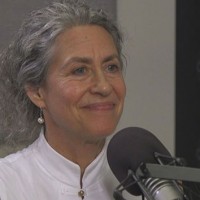
 ABC News(NEW YORK) — Before Lama Tsomo became one of the first American women ordained as a Tibetan Buddhist lama, or spiritual teacher, she was Linda Pritzker, part of the famous Pritzker family that built the Hyatt Hotel chain.
ABC News(NEW YORK) — Before Lama Tsomo became one of the first American women ordained as a Tibetan Buddhist lama, or spiritual teacher, she was Linda Pritzker, part of the famous Pritzker family that built the Hyatt Hotel chain.
Lama Tsomo sat down with ABC News’ Dan Harris for his livestream podcast show, 10% Happier With Dan Harris, to talk about what she has learned on her journey to becoming a lama and how it changed her life forever.
“I have two different names I truly do identify or respond to,” she said. “And it’s loosened my ego identification in a way because I’ll answer the phone and I won’t know, ‘Am I Lama Tsomo in this conversation or Linda Pritzker in this conversation?'”
An heiress with a well-connected family, Lama Tsomo decided not to join any of the family businesses. Instead, she left college around age 20 — though she later went back for her bachelors and masters degrees — became a homesteader where she raised goats, got married, had three children and later got divorced.
She eventually found meditation and dove deeply into Buddhism, went on months-long retreats, learned Tibetan and now she teaches all over the world.
Lama Tsomo is also a co-founder of the Namchak Foundation and has written a book called Why Is the Dalai Lama Always Smiling, in which she shares her story about her life and details some of the Tibetan Buddhist practices, including a meditation technique she calls the “Tibetan Nose Blow.”
“If you just think about the fact that we’re trying to pull stuff to us if we want it, or push stuff away that we don’t want, and we’re occupying ourselves with that all the time, imagine if we could just part the clouds of that effort for a little bit, wouldn’t that be nice?” she said. “And that’s what this practice helps us to do, and so then we can sit in clear, calm meditation right away.”
When she first started meditating, Lama Tsomo said she tried to do it on her own, gave up and didn’t pick it up again until years later.
“I was really off-course,” she said. “I was with the wrong people, doing the wrong stuff, and that kind of thing, living in the wrong place. And I kind of like, ‘came to’ and said, ‘No, no, this is not my path in life. This is not the life I need to live.'”
“And so I decided I have to resume meditating,” Lama Tsomo continued. “Because I realized … all the thousands of decisions I was making throughout my day were that much more on track because I had tuned into myself.”
By her late 30s, Lama Tsomo said she had studied many different forms of meditation, from Theravada, a sort of “old school Buddhism,” she said, to Zen meditation and found the strongest comfort with Tibetan Buddhism after she recognized she had found a teacher with whom she could connect.
“Recognition is a funny thing,” she said. “The lama-student relationship is different than meeting your spouse, but there’s still this sort of recognition moment where you go, ‘Oh, this is the person for me.’ It’s interesting. It is a very intimate relationship, but not at all romantic.”
Lama Tsomo is a student of Gochen Tulku Sang-ngag Rinpoche, under whom she completed three years’ worth of traditional practice, and he bestowed on her the lama title.
She went into great detail about the different Tibetan Buddhist teachings and her interpretations, such as what achieving enlightenment meant to her and the controversial belief in reincarnation or having past lives. But another practice she talked about was using meditation as a way to channel sympathy for others’ suffering and then replace their pain with feelings of compassion.
“You imagine that suffering person in front of you and you’re seeing their suffering face,” she said. “Now you use your breath to really make it real, and you breathe in their suffering into your heart which is a bit of an act of courage. But if you’re feeling moved by an act of compassion, you just want to take away their suffering and replace it with happiness.”
“You imagine these sort of dense, thick dark clouds of the suffering,” Lama Tsomo continued. “And then you breathe out these bright white clouds into them and you see their face changing into a smile.”
For those who are skeptical or curious about these teachings, Lama Tsomo suggested doing what she did by having “openness, with asking a lot of questions.”
“I think as we get older, we tend to learn less because we tend to decide what’s what and that makes less room for learning,” she said. “So I try to sort of work against time and try to keep the blinders open.”
Copyright © 2016, ABC Radio. All rights reserved.














